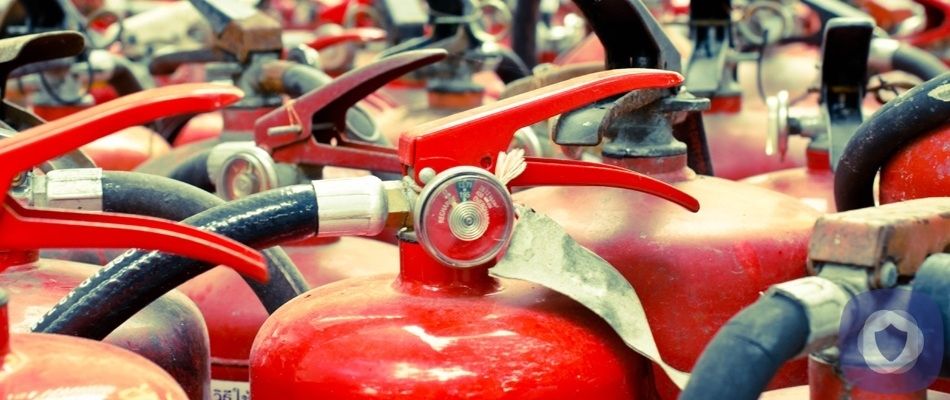If you’re looking to purchase a fire extinguisher, you may be surprised to learn that there are several different types. A portable fire extinguisher is often listed as an essential home safety tool, and they’re legally required for many workplaces and industrial facilities. But you must be buying a fire extinguisher and incorporate it into your fire safety plan for your home or workplace. To do this most effectively, you should learn about the five different types of fire extinguishers, split into an ABC acronym classification based on the different classes of fire.
You’d be forgiven for thinking that fire extinguishers were universal and able to be used on any fire, but this isn’t so. The issue is that different types of fires must be dealt with differently. While water may work to put out a traditional campfire, it can be dangerous to apply it to other fires, such as electrical fires. Therefore there are different variations with different uses. Let’s look at the different types of fire extinguishers and what can be used to help you choose the suitable fire extinguisher for your home or business.
Class A fires
A class A fire comprises ordinary combustible materials such as paper, rubber, clothes, and plastics. One of the most recognizable hallmarks of a Class A fire is its fuel sources leave ash behind after burning. These are the simplest types of fires and involve materials commonly found in homes and offices. These fires are suited for Class A fire extinguishers.
Class A Fire Extinguishers: Types
As we’ve already mentioned, there are many different types of fire extinguishers. Even the classes can be broken down into several groups. For Class A fires, these include.
- Water: The simplest solution for the most precise fire class, there’s little risk of using a water extinguisher for a class A fire.
- Foam: This extinguisher helps cool and suffocate fires and is used for larger class A fires.
- Multipurpose Dry Chemical: Multipurpose dry chemical fire extinguishers are effective for most fire types, including class A, B, and C fires. The agent disrupts the fire triangle (fuel, oxygen, heat). With that said, standard (BC) dry chemicals (sodium bicarbonate-based) are not recommended for class A fires.
- Water Mist: The newest development, water mist extinguishers, can avoid the damage caused by regular water extinguishers and is safe to use on electric wiring. This agent removes heat from the fire and is used in class A fires and a class C hazard.
Class B fires
Class B fire extinguishers are rated on flammable products like grease, gasoline, and oil. We’ll look at various extinguishers to see which ones can be used to suppress class B fires safely.
Class B fire extinguishers
- Co2: A carbon dioxide fire extinguisher works well for class B fires; it expels Co2 to suffocate the fire, neutralizing the fire triangle. However, it would help if you were careful as the effective range is minimal—3+ feet from the fire.
- Foam: These extinguishers work on both Class A and B fires. The foaming agent works on class B fires by separating the fuel and oxygen. However, these extinguishers only work when the flammable liquid isn’t free-flowing.
- Dry Chemical: Dry chemical extinguishers are classified as B fires as their agent extinguishes a fire by interrupting the chemical reaction of the fire triad. These extinguishers have a much better range.
- Clean Agent: A clean agent extinguisher uses an extinguishing agent that works by interrupting the chemical reaction of the fire and removing the heat.
Safety Tip: Do not attempt to extinguish a fire involving flammable gas unless there is a reasonable assurance you can promptly shut off the fuel source. If the only fuel burning is the leaking gas, the best method for extinguishing the fire is to shut off the fuel supply. Extinguishing a flammable gas fire without shutting off the fuel will allow unburned gas to escape into the atmosphere, which may permit a dangerous accumulation of gas to develop, and an explosion may occur if the gas is exposed to an ignition source.
Related: Check our picks for the best fireproof safes
Class C fires
Due to the unique hazards of Class C fires, it is imperative to use only a Class C fire extinguisher to combat them. Class C fires involve electrical equipment.
Due to the risks associated with class C fires, you must use the correct extinguishers on them. As we’ve already covered, water-based extinguishers (apart from mist) are dangerous to use.
Class C fire extinguishers
- Carbon Dioxide: Co2 extinguishers work well for Class C fires as they smother the fire and deprive it of oxygen.
- Dry Chemical: The regular dry chemical extinguisher is well-rated for class C and B fires.
- Clean agent: Like dry chemical extinguishers, the clean agents interrupt the fire triangle’s chemical reaction. The main difference between a clean agent and a dry chemical extinguisher is that a clean agent extinguisher leaves no residue.
- Water Mist: The water mist extinguisher is unlike a standard water-based extinguisher and can be used on class C hazards without risking electrocution. Smaller amounts of de-ionized water are used; this doesn’t conduct electricity.
Class D fires
Class D fire extinguishers are used on combustible metals like magnesium and titanium. These fires require an extinguishing agent that will not react with the burning metal. All Class D fire extinguishers use a dry powder agent to smother the fire and absorb heat, suppressing the fire.
Class D fire extinguishers
This fire extinguisher works by smothering the flame with a dry powder, replacing the previous method of dealing with a metal fire, which involved covering it with sand or some other non-flammable dry material that could smother the flame. This serves two purposes. First, the fire is cut off from oxygen, and secondly, the powder expelled can absorb the heat from the flame.
Class K Fires
Class K fires are similar to Class B fires (those fueled by petroleum products) since they both involve flammable liquids. Class K fires proliferate when liquids and materials such as cooking oils, cooking grease, animal fats, and vegetable fats serve as the fuel source.
Commercial kitchens are associated with high-volume cooking activities which produce large amounts of grease or oil. A class K fire extinguisher is necessary to have close by to effectively suppress and defeat the fires that are most likely to occur in these locations. A class K fire extinguisher should also be used with a fire suppression system.
Class K fire extinguishers
The only effective extinguisher rated as Class K is the Wet Chemical fire extinguisher. These extinguishers use a wet mist containing an alkaline mixture, like potassium carbonate, potassium acetate, or potassium citrate, which interact with the fuel of the fire (oil, grease, or fat) to create a type of foam that blankets the oil or grease, cooling it and preventing it from being fed oxygen. The extinguishing agent successfully quenches the fire and lessens the risk of reignition.
The Final Word
Whether you’re working in a commercial kitchen with industrial fryers or want to increase your fire protection at home, a fire extinguisher is a wise addition to a comprehensive fire safety plan involving a fire alarm, smoke detectors, and other fire safety equipment.
This article has been reviewed and approved by Officer Banta.

Officer Banta is the official SecurityNerd home security and safety expert. A member of the Biloxi Police Department for over 24 years, Officer Banta reviews all articles before lending his stamp of approval. Click here for more information on Officer Banta and the rest of our team.

